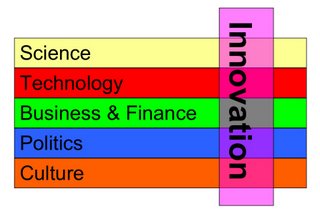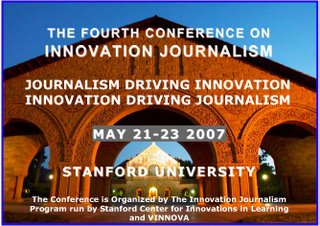
Innovation Journalism is about mixing the traditional
news beats. That may be more difficult to do on paper than on the web. Here is why:
The innovation story is nowadays rarely about tech OR business OR politics OR culture. It's increasingly about the mix of them. For those who need an example: Look first at the introduction of the music CD. Tech news reported on it in 1979. It was introduced to the market in 1982, and a few years later the business news could report on how it was taking over the market. That gave the news consumers the full story. Then look at what happened one decade later, when MP3-music got onto the Internet. This time the story was different - tech, business and culture were nested. Technology, business models, legal frameworks and culture are all interacting components of the story, and none of these components can reveal the story on their own. Which section should it be printed on in the newspaper?
Tricky choice! It can only be printed in one news section, no one will print the same story in several places in the newspaper. Each section has a title and character of its own, like "business", "technology" or "culture", and is headed by an editor who is responsible for what goes in. Newsrooms are built for speed. News editors will have an easier life not overlapping each other. So many of them will drop important parts of a story in order to make it fit into their slot and not tread on any other editor's turf.
Ergo - news on paper offers a snug fit for a traditional line organization. The organization of the work force mirrors the structure of the newspaper. Each employee reports to one boss. And this usually means a bumpy and unsafe road for maverick writers attempting to cross the lines, trying to work with several bosses. Mixing tech, business, politics and culture - that can mean trouble for a writer!
The Web offers different circumstances than paper does. News sections are no longer physical spaces, they are tags. Each story can easily carry several tags, so there is no problem running the same story as "culture" and "business" and "tech" at the same time. There is no problem introducing multidisciplinary labels, like "innovation". Beats can overlap.
I am not saying that organizations doing news on the web can't be organized like paper newsrooms - many of them are. The point is: they don't have to! The crucial difference to paper news: News on the web does not inherently enforce a line organization with separated news beats.
 The Fourth Conference on Innovation Journalism is a gathering for professionals to discuss the interaction between journalism and innovation, including how innovation is changing the profession and business of journalism, how to cover innovation in the news, and how journalism links innovation with society. Target participants for the conference include journalists, professionals connected to the media/communications industry, innovation experts, students, and researchers.
The Fourth Conference on Innovation Journalism is a gathering for professionals to discuss the interaction between journalism and innovation, including how innovation is changing the profession and business of journalism, how to cover innovation in the news, and how journalism links innovation with society. Target participants for the conference include journalists, professionals connected to the media/communications industry, innovation experts, students, and researchers.

















